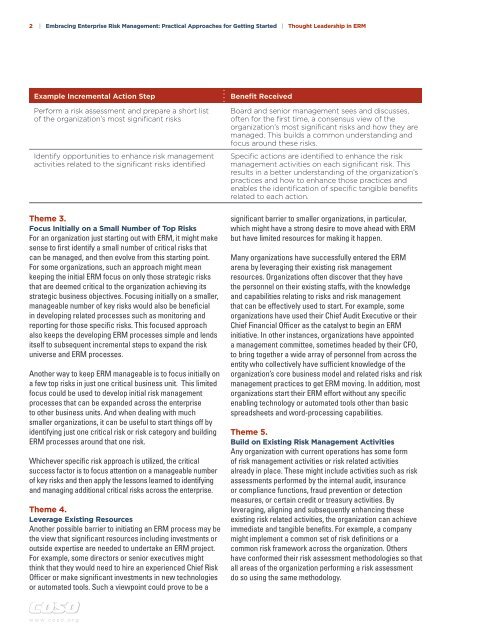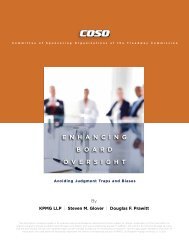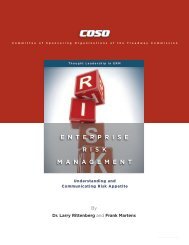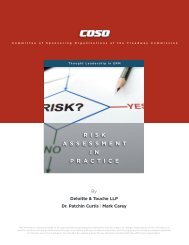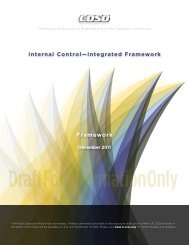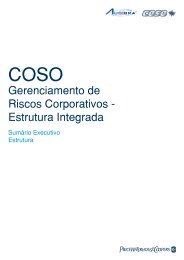Embracing Enterprise Risk Management: Practical - Coso
Embracing Enterprise Risk Management: Practical - Coso
Embracing Enterprise Risk Management: Practical - Coso
You also want an ePaper? Increase the reach of your titles
YUMPU automatically turns print PDFs into web optimized ePapers that Google loves.
2 | <strong>Embracing</strong> <strong>Enterprise</strong> <strong>Risk</strong> <strong>Management</strong>: <strong>Practical</strong> Approaches for Getting Started | Thought Leadership in ERM<br />
Example incremental Action Step<br />
Perform a risk assessment and prepare a short list<br />
of the organization’s most significant risks<br />
Identify opportunities to enhance risk management<br />
activities related to the significant risks identified<br />
Theme 3.<br />
Focus initially on a Small number of Top <strong>Risk</strong>s<br />
For an organization just starting out with ERM, it might make<br />
sense to first identify a small number of critical risks that<br />
can be managed, and then evolve from this starting point.<br />
For some organizations, such an approach might mean<br />
keeping the initial ERM focus on only those strategic risks<br />
that are deemed critical to the organization achieving its<br />
strategic business objectives. Focusing initially on a smaller,<br />
manageable number of key risks would also be beneficial<br />
in developing related processes such as monitoring and<br />
reporting for those specific risks. This focused approach<br />
also keeps the developing ERM processes simple and lends<br />
itself to subsequent incremental steps to expand the risk<br />
universe and ERM processes.<br />
Another way to keep ERM manageable is to focus initially on<br />
a few top risks in just one critical business unit. This limited<br />
focus could be used to develop initial risk management<br />
processes that can be expanded across the enterprise<br />
to other business units. And when dealing with much<br />
smaller organizations, it can be useful to start things off by<br />
identifying just one critical risk or risk category and building<br />
ERM processes around that one risk.<br />
Whichever specific risk approach is utilized, the critical<br />
success factor is to focus attention on a manageable number<br />
of key risks and then apply the lessons learned to identifying<br />
and managing additional critical risks across the enterprise.<br />
Theme 4.<br />
Leverage Existing Resources<br />
Another possible barrier to initiating an ERM process may be<br />
the view that significant resources including investments or<br />
outside expertise are needed to undertake an ERM project.<br />
For example, some directors or senior executives might<br />
think that they would need to hire an experienced Chief <strong>Risk</strong><br />
Officer or make significant investments in new technologies<br />
or automated tools. Such a viewpoint could prove to be a<br />
w w w . c o s o . o r g<br />
benefit Received<br />
Board and senior management sees and discusses,<br />
often for the first time, a consensus view of the<br />
organization’s most significant risks and how they are<br />
managed. This builds a common understanding and<br />
focus around these risks.<br />
Specific actions are identified to enhance the risk<br />
management activities on each significant risk. This<br />
results in a better understanding of the organization’s<br />
practices and how to enhance those practices and<br />
enables the identification of specific tangible benefits<br />
related to each action.<br />
significant barrier to smaller organizations, in particular,<br />
which might have a strong desire to move ahead with ERM<br />
but have limited resources for making it happen.<br />
Many organizations have successfully entered the ERM<br />
arena by leveraging their existing risk management<br />
resources. Organizations often discover that they have<br />
the personnel on their existing staffs, with the knowledge<br />
and capabilities relating to risks and risk management<br />
that can be effectively used to start. For example, some<br />
organizations have used their Chief Audit Executive or their<br />
Chief Financial Officer as the catalyst to begin an ERM<br />
initiative. In other instances, organizations have appointed<br />
a management committee, sometimes headed by their CFO,<br />
to bring together a wide array of personnel from across the<br />
entity who collectively have sufficient knowledge of the<br />
organization’s core business model and related risks and risk<br />
management practices to get ERM moving. In addition, most<br />
organizations start their ERM effort without any specific<br />
enabling technology or automated tools other than basic<br />
spreadsheets and word-processing capabilities.<br />
Theme 5.<br />
build on Existing <strong>Risk</strong> <strong>Management</strong> Activities<br />
Any organization with current operations has some form<br />
of risk management activities or risk related activities<br />
already in place. These might include activities such as risk<br />
assessments performed by the internal audit, insurance<br />
or compliance functions, fraud prevention or detection<br />
measures, or certain credit or treasury activities. By<br />
leveraging, aligning and subsequently enhancing these<br />
existing risk related activities, the organization can achieve<br />
immediate and tangible benefits. For example, a company<br />
might implement a common set of risk definitions or a<br />
common risk framework across the organization. Others<br />
have conformed their risk assessment methodologies so that<br />
all areas of the organization performing a risk assessment<br />
do so using the same methodology.


